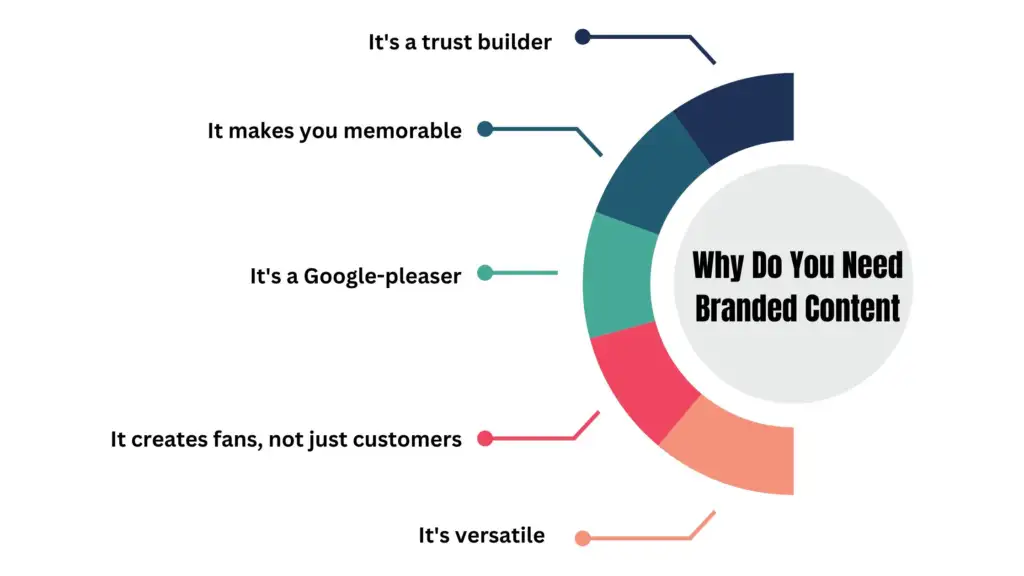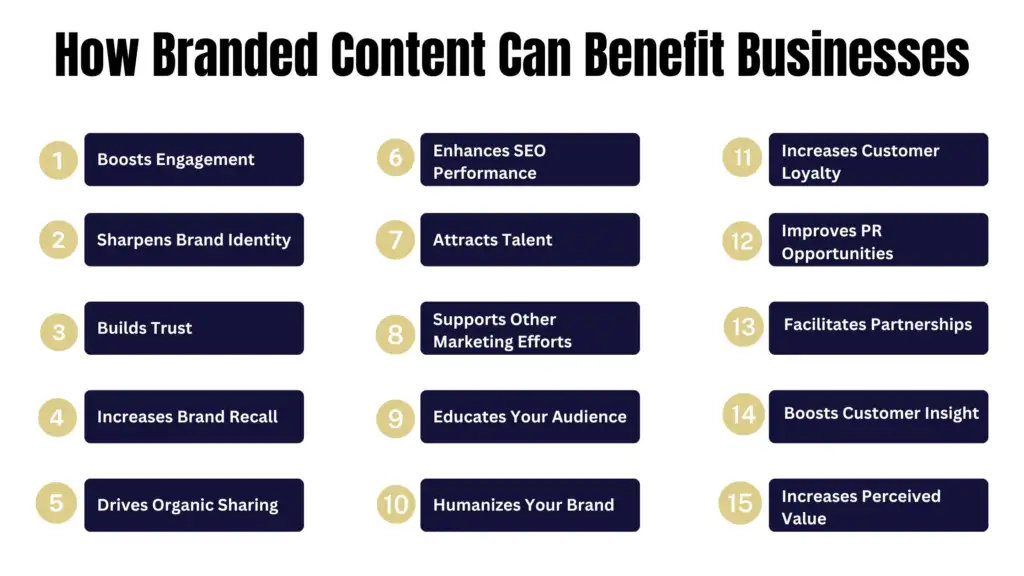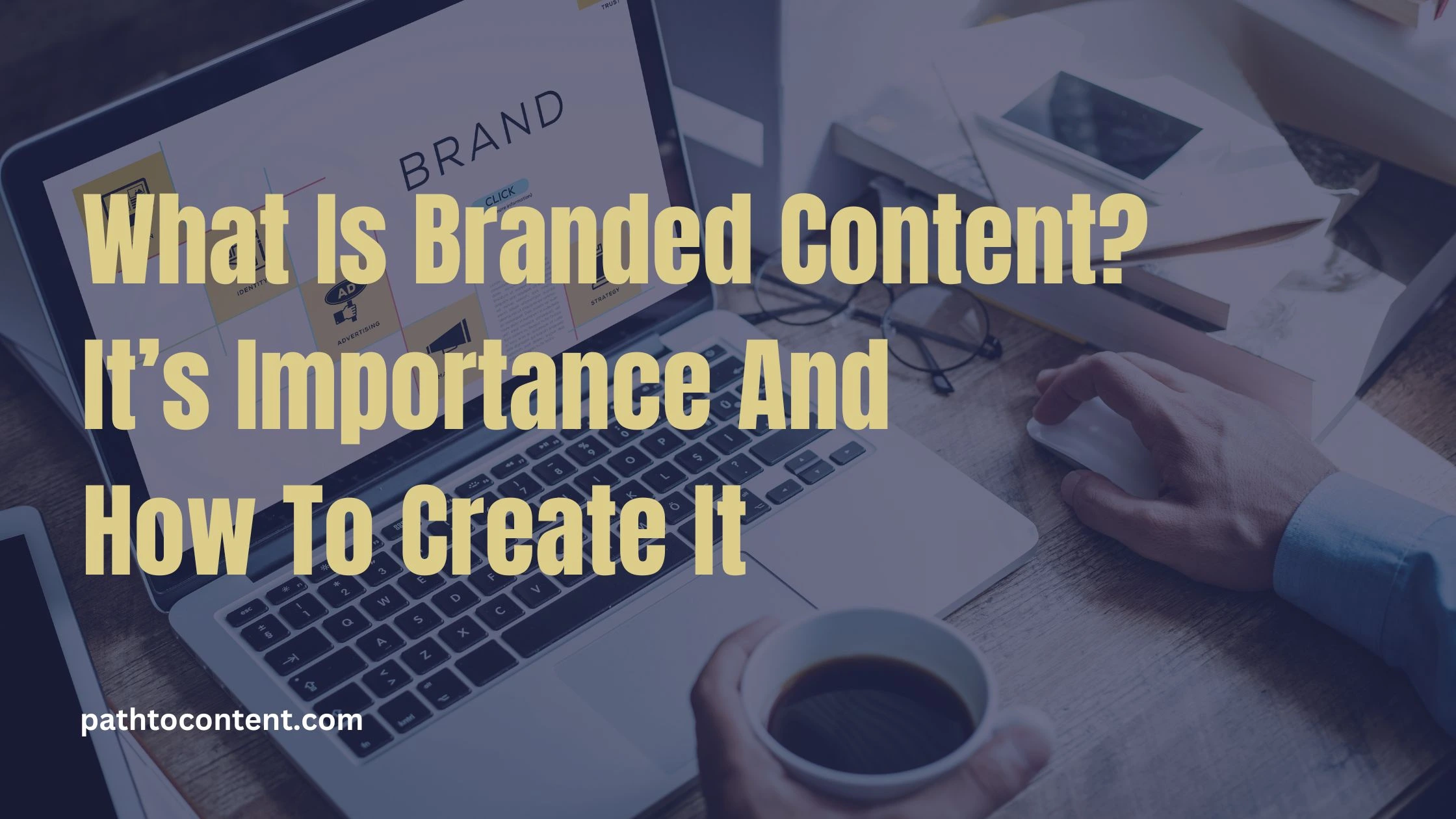Gone are the days when only fulfilling the SEO aspects could boost your search rankings. The audience is changing, and so is Google. It’s time for you to build your brand authority through branded content.
What is branded content? It’s your brand’s backstage pass to search engine success. A company’s brand is not just about what it sells but also about who it is, what makes it unique, and why anyone should care about it.
When deciding whether to rank your site, Google now focuses more on your overall brand appeal and other SEO terms, such as DA and backlinks. (According to the new study done by Moz) which makes perfect sense.
- So, what’s branded content?
- How does it help your business?
- How to create it?
I’m answering it all today. Let’s begin.

Importance of Branded Content for Building Brand Authority
As I already said, Google is changing the parameters it uses to analyze websites. Earlier, you could rank by checking the SEO boxes. Going forward, the real winners will be those who know how to build a brand ecosystem and create content that sets their brand apart.
A brand’s content promotes trust, displays expertise, and tells its own unique story. It’s how you stand out in a sea of sameness and get Google to notice.
Content is getting saturated, and mediocrity is ruling. To help its users, Google thinks it’s best to help those websites that have built a brand outside of Google. Simply put, the more people trust your brand, the better your rankings.
Know what helps you gain trust faster? Branded content.
Branded content is key to achieving this, as it creates meaningful connections between the brand and the audience. When brands tell authentic stories, they foster trust. They build authority by aligning those stories with their core values and mission.
Over time, consistent branded content can position a brand as an industry leader, fostering long-term customer loyalty and engagement.
What Is Branded Content & Why Do You Need It?
Branded content is your chance to show off your brand’s personality without shoving your products in people’s faces. It’s the stories you tell, the values you champion, and the experiences you create that make your audience think, “Hey, I like these guys.”
Think of it as the difference between a pushy salesperson and a friend giving you advice. Branded content is that friend – helpful, engaging, and not trying to sell you something.
So why bother? Here’s why:

- It’s a trust builder: People buy from brands they trust
- It makes you memorable: Good branded content sticks in people’s minds in a world of forgettable ads.
- It’s a Google-pleaser: Search engines are getting smarter. They’re starting to favor brands that people actually care about, not just those who tick SEO boxes.
- It creates fans, not just customers: When done right, branded content turns casual browsers into loyal followers who’ll always choose you over competitors.
- It’s versatile: From social media posts to long-form articles, branded content can take many forms, giving you plenty of ways to connect with your audience.
The bottom line? Branded content is becoming essential for any brand that wants to stay relevant, build trust, and, yes, rank well on search engines. It’s your way of saying, “We’re not just another faceless company – we’re a brand worth paying attention to.”
Note: Slowly, we’re heading in the direction of zero-click searches. It means even ranking on the first page of SERPs might not help you acquire traffic. The overall traffic of websites will decrease. But there’s still a way to keep your lead generation and sales intact.
Rand Fishkin’s latest post discussed being present in the right places to help people know you as a brand and what you do.

In addition, branded content is the perfect way to let your audiences (at the right places) know you and your brand so they can search for it even if it’s not shown in the zero-click results.
| Suggested reading: How to avoid Google updates from affecting your website?
How is Branded Content Different from Existing Content Marketing?
| Aspect | Branded Content | Content Marketing |
|---|---|---|
| Purpose | Storytelling, emotions, brand values | Shows the human side of brands |
| Focus | Creating experiences and emotional connections | Creating a content funnel from top to bottom |
| Approach | Shows human side of brands | Explains solutions and educates |
| Goal | Raise brand recall and create deeper connections | Gain audience and nurture customers |
| Sales Approach | Indirect | More direct |
Both branded content and content marketing serve different purposes.
Content marketing helps you create a content funnel from top to bottom to gain an audience and nurture them after they convert into customers. It focuses on educating the audience, explaining solutions to their problems, and guiding them through the buyer’s journey.
Branded content revolves more around storytelling, emotions, and brand values. It’s about creating experiences that create an emotional connection with the audience. It raises the recall value of your brand by assisting your audience in remembering and connecting with it.
Though you don’t sell through branded content, it ultimately helps increase sales. Rather than just selling a product, branded content shows the human side of brands, enabling brands to connect on a deeper level.
When done well, branded content builds trust, demonstrates expertise, and enhances the brand’s reputation over time.
How Branded Content Can Benefit Businesses

- Boosts Engagement: Turns passive viewers into active participants.
- Sharpens Brand Identity: Helps you stand out in a sea of sameness.
- Builds Trust: Consistent, authentic content creates lasting relationships.
- Increases Brand Recall: Makes your brand stick in people’s minds.
- Drives Organic Sharing: Creates content people actually want to share.
- Enhances SEO Performance: Aligns with Google’s focus on brand authority.
- Attracts Talent: Shows potential employees what you’re all about.
- Supports Other Marketing Efforts: This fuels social media, email, and more.
- Educates Your Audience: Positions your brand as a go-to information source.
- Humanizes Your Brand: Gives your company a relatable personality.
- Increases Customer Loyalty: Keeps people coming back for more than just products.
- Improves PR Opportunities: Gives media something interesting to talk about.
- Facilitates Partnerships: Opens doors for collaborations with other brands.
- Boosts Customer Insight: Engagement with content provides valuable data.
- Increases Perceived Value: Makes your offerings seem more premium.
How to Develop Your Branded Content Strategy
Audience Analysis
Like every other strategy in the content universe, branded content strategy starts with understanding the audience. In fact, when branded content is about creating content that helps you build a connection with your audience, it only makes sense to analyze what the audience wants.
First of all, begin by being at the right places. Sparktoro will help you with that. Enter the seed keyword or search query related to your brand and check where the audiences hang out the most.
For example, if I search for “blogging,” Sparktoro will list websites my audiences often visit, the social media platforms they use the most, the podcasts they listen to, the Reddit communities they frequent, etc.
Be at the places your audience is at.
Secondly, understand the type of content they consume on these platforms. Your content, though unique given your brand, should align with the topics your audience is interested in.
Knowing your audience inside out is the key to creating a successful branded content strategy.
Define Your Brand Voice
A major chunk of brand consistency is a consistent brand voice. A consistent voice and tone help define how you want readers to feel about your brand.
Your brand voice is how you say what you say. Think of the voice as the depiction of your brand’s personality.
What type of personality does your brand have?
- Witty
- Caring
- Quirky
- Uplifting
- Powerful
- Ambitious
- Competent
- Professional
- Sophisticated
The brand voice decides how you’ll sound to your audience. It remains consistent in all your communications.
It creates a recall value as people start perceiving your brand as a person.
For example: When you think of Dove, you think of an empowering and uplifting voice. With Harley Davidson, the voice changes to convey strength and aggression.
You need a unique and defined brand voice that reflects your personality, values, and, most importantly, the feelings you want to invoke in your audience.
Tell Compelling Stories
Remember, your goal with branded content is not selling but connecting. And what’s the best medium for building connections? Storytelling.
Stories remain long after they’ve been told. Build strong narratives in all branded content you put out. The stories can be of your own, your customers, or a fictional story you create that conveys your messaging. The goal is to build an emotional connection with your audience.
Showcase Your Values
Another key aspect of branded content is authenticity. What better way to show authenticity than being outspoken about your values?
Audiences can identify inauthenticity. It’s your chance to prove you’re more than just another faceless corporation out for a quick buck.
So, how do you walk the talk? Here are a few ideas:
- Take a stand, and don’t be afraid to be vocal about it. Choose topics that are close to you and relate to your brand. Don’t get into it for the publicity, but because you care.
- Use transparency as your currency. Share your true journey, including the challenges and any advantages you had. Share if you made mistakes or if you got help from others. Own your true story.
- Employees are the most effective representatives of your brand. Get them to discuss their opinions and experiences. It also demonstrates that you embody your principles both inside and outside of your brand, humanizing it.
- Select collaborations that share your beliefs. Collaborating with brands or influencers who embody your values strengthens your dedication and broadens your audience to include like-minded individuals.
Leverage User-Generated Content (UGC)
UGC meets all the criteria for creating branded content—trust, customer involvement, authenticity, and real content.
AirBnB leverages UGC smartly by sharing a section in its blog dedicated to Host stories. The content focuses on how the hosts earned benefits or made money using AirBnB’s features.
It’s helping them build brand authority by using real customer stories and subtly selling their service.
Collaborate with Influencers
This method has been on the boom in recent years. People spend most of their time online on social media, so many brands use this to benefit by making brand deals.
Content creators create stories or ad films in which the brand is not the central focus but the story. Then, they naturally integrate the brand subtly in a way that aligns with their storytelling and doesn’t come across as pushing their audiences into buying.
Many YouTubers are doing this smartly, but the one example that stands out for me is a YouTube channel in a regional Indian language (Marathi) called BhaDiPa. They’ve been consistently creating short videos and web series that naturally integrate the brand in a way that enhances the content and also helps their audience learn more about the brand.
A noteworthy effort is their web series Odd Vata, which is dedicated to interviewing successful brands and businesses that have made it big in their respective industries.
Create Stories That Highlight the Benefits of Your Product or Service
I know. I already said branded content isn’t the same as traditional marketing. But that doesn’t mean you should not highlight your product or service at all.
Think outside the box to feature your product naturally through stories. GoPro is an example of a brand using stories to highlight products naturally. The brand has collaborated with major brands such as Ford and Wimboldon to share the brands’ stories and connect them with their audience while showcasing its products’ features.
If you look at the videos, you’ll see that they’re not about GoPro but still have a subtle feature.
Measuring Success and ROI
The key metrics for measuring branded content performance are:
| Metric | Description |
|---|---|
| Engagement Rates | Likes, shares, comments on content |
| Brand Mentions | Organic references in user-generated content |
| Brand Recall | Measured through social listening, surveys, search trends |
| Branded Searches | The overall tone of brand conversations |
| Sales and Lead Quality | Impact on business outcomes |
| Social Sentiment | Overall tone of brand conversations |
| Website Conversions | Actions taken on the website after engaging with branded content |
- Engagement rates, such as likes, shares, comments, etc., on the content
- Brand mentions by audiences in their content, such as social media posts, blog articles, video content, etc., where your brand is organically referenced or discussed
- Brand recall value. It can be measured through social media listening, surveys, search volume trends, etc.
- Branded organic searches
- Sales and leads quality
- Social sentiment can be measured using a sentiment analysis tool to understand the overall tone of conversations about your brand
- Website conversions
| Suggested reading: Blog rebrand guide
Frequently Asked Questions
1. How does branded content differ from traditional advertising?
Unlike traditional advertising that directly promotes products, branded content is subtle and immersive, focusing on creating positive brand associations through stories and experiences without feeling “sold to.”
2. Can small businesses benefit from branded content?
Yes, small businesses can benefit from branded content by developing strategies aligned with their values and storytelling potential. This can help them build trust and credibility with their audience.
3. How often should I publish branded content?
The frequency isn’t specified, but consistency is critical. Regularly publish content that aligns with your overall marketing strategy and audience interests.
4. What platforms are best for distributing branded content?
While specific platforms aren’t mentioned, the article suggests being present where your audience is. Use tools like Sparktoro to identify the most relevant platforms for your target audience.
5. How do I handle negative feedback on my branded content?
Handle negative feedback professionally, acknowledge valid points, and constructively use criticism to improve future content. View it as an opportunity for growth and refinement of your strategy.
Final Thoughts
Branded content can become just the right tool for your marketing asset. Whether you’re a small business or an established brand, creating branded content helps you connect better and establish authority without selling hard.
Given how trust is becoming more and more important, the audience will love seeing you share branded content that actually helps them see the real you behind the brand.



